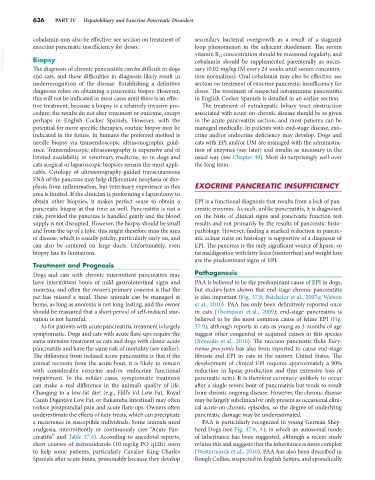Page 664 - Small Animal Internal Medicine, 6th Edition
P. 664
636 PART IV Hepatobiliary and Exocrine Pancreatic Disorders
cobalamin may also be effective: see section on treatment of secondary bacterial overgrowth as a result of a stagnant
exocrine pancreatic insufficiency for doses. loop phenomenon in the adjacent duodenum. The serum
VetBooks.ir Biopsy vitamin B 12 concentration should be measured regularly, and
cobalamin should be supplemented parenterally as neces-
The diagnosis of chronic pancreatitis can be difficult in dogs
tion normalizes). Oral cobalamin may also be effective: see
and cats, and these difficulties in diagnosis likely result in sary (0.02 mg/kg IM every 24 weeks until serum concentra-
underrecognition of the disease. Establishing a definitive section on treatment of exocrine pancreatic insufficiency for
diagnosis relies on obtaining a pancreatic biopsy. However, doses. The treatment of suspected autoimmune pancreatitis
this will not be indicated in most cases until there is an effec- in English Cocker Spaniels is detailed in an earlier section.
tive treatment, because a biopsy is a relatively invasive pro- The treatment of extrahepatic biliary tract obstruction
cedure; the results do not alter treatment or outcome, except associated with acute-on-chronic disease should be as given
perhaps in English Cocker Spaniels. However, with the in the acute pancreatitis section, and most patients can be
potential for more specific therapies, routine biopsy may be managed medically. In patients with end-stage disease, exo-
indicated in the future. In humans the preferred method is crine and/or endocrine deficiency may develop. Dogs and
needle biopsy via transendoscopic ultrasonographic guid- cats with EPI and/or DM are managed with the administra-
ance. Transendoscopic ultrasonography is expensive and of tion of enzymes (see later) and insulin as necessary in the
limited availability in veterinary medicine, so in dogs and usual way (see Chapter 49). Most do surprisingly well over
cats surgical or laparoscopic biopsies remain the most appli- the long term.
cable. Cytology of ultrasonography-guided transcutaneous
FNA of the pancreas may help differentiate neoplasia or dys-
plasia from inflammation, but veterinary experience in this EXOCRINE PANCREATIC INSUFFICIENCY
area is limited. If the clinician is performing a laparotomy to
obtain other biopsies, it makes perfect sense to obtain a EPI is a functional diagnosis that results from a lack of pan-
pancreatic biopsy at that time as well. Pancreatitis is not a creatic enzymes. As such, unlike pancreatitis, it is diagnosed
risk, provided the pancreas is handled gently and the blood on the basis of clinical signs and pancreatic function test
supply is not disrupted. However, the biopsy should be small results and not primarily by the results of pancreatic histo-
and from the tip of a lobe; this might therefore miss the area pathology. However, finding a marked reduction in pancre-
of disease, which is usually patchy, particularly early on, and atic acinar mass on histology is supportive of a diagnosis of
can also be centered on large ducts. Unfortunately, even EPI. The pancreas is the only significant source of lipase, so
biopsy has its limitations. fat maldigestion with fatty feces (steatorrhea) and weight loss
are the predominant signs of EPI.
Treatment and Prognosis
Dogs and cats with chronic intermittent pancreatitis may Pathogenesis
have intermittent bouts of mild gastrointestinal signs and PAA is believed to be the predominant cause of EPI in dogs,
anorexia, and often the owner’s primary concern is that the but studies have shown that end-stage chronic pancreatitis
pet has missed a meal. These animals can be managed at is also important (Fig. 37.8; Batchelor et al., 2007a; Watson
home, as long as anorexia is not long-lasting, and the owner et al., 2010). PAA has only been definitively reported once
should be reassured that a short period of self-induced star- in cats (Thompson et al., 2009); end-stage pancreatitis is
vation is not harmful. believed to be the most common cause of feline EPI (Fig.
As for patients with acute pancreatitis, treatment is largely 37.9), although reports in cats as young as 3 months of age
symptomatic. Dogs and cats with acute flare-ups require the suggest other congenital or acquired causes in this species
same intensive treatment as cats and dogs with classic acute (Xenoulis et al., 2016). The raccoon pancreatic fluke Eury-
pancreatitis and have the same risk of mortality (see earlier). trema procyonis has also been reported to cause end-stage
The difference from isolated acute pancreatitis is that if the fibrosis and EPI in cats in the eastern United States. The
animal recovers from the acute bout, it is likely to remain development of clinical EPI requires approximately a 90%
with considerable exocrine and/or endocrine functional reduction in lipase production and thus extensive loss of
impairment. In the milder cases, symptomatic treatment pancreatic acini. It is therefore extremely unlikely to occur
can make a real difference in the animal’s quality of life. after a single severe bout of pancreatitis but tends to result
Changing to a low-fat diet (e.g., Hill’s i/d Low Fat, Royal from chronic ongoing disease. However, the chronic disease
Canin Digestive Low Fat, or Eukanuba Intestinal) may often may be largely subclinical or only present as occasional clini-
reduce postprandial pain and acute flare-ups. Owners often cal acute-on-chronic episodes, so the degree of underlying
underestimate the effects of fatty treats, which can precipitate pancreatic damage may be underestimated.
a recurrence in susceptible individuals. Some animals need PAA is particularly recognized in young German Shep-
analgesia, intermittently or continuously (see “Acute Pan- herd Dogs (see Fig. 37.8, A), in which an autosomal mode
creatitis” and Table 37.4). According to anecdotal reports, of inheritance has been suggested, although a recent study
short courses of metronidazole (10 mg/kg PO q12h) seem refutes this and suggests that the inheritance is more complex
to help some patients, particularly Cavalier King Charles (Westermarck et al., 2010). PAA has also been described in
Spaniels after acute bouts, presumably because they develop Rough Collies, suspected in English Setters, and sporadically

